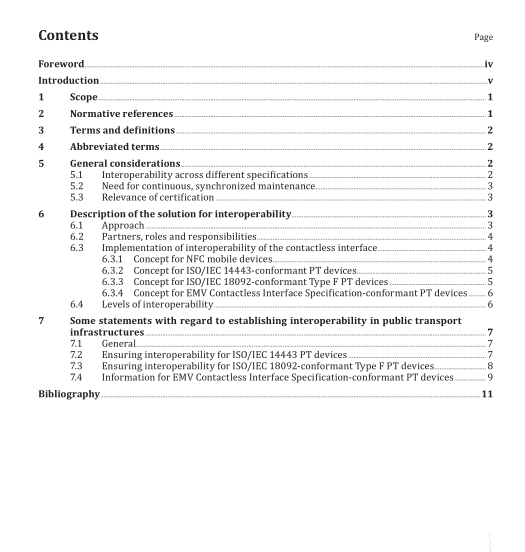ISO TR 20527:2022 pdf download.Intelligent transport systems — Interoperability between interoperable fare management (IFM) systems and near field communication (NFC) mobile devices
5.2 Need for continuous, synchronized maintenance
The standards or specifications mentioned in 5.1 are owned and maintained by individual bodies and working parties. In order to guarantee interoperability for current and future versions, the responsible bodies establish continuous working relationships that support alignment and synchronization before any changes are released. Liaisons which established harmonization of contactless specification releases are in place between the bodies that maintain the NFC Forum specifications, the ISO/IEC TS 24192 series, ISO/IEC 18092 and the EMV Contactless Interface Specification, as well as the related communication signal interfaces.
The continuous working relationships between these specification bodies ensures future-proofed interoperability between PT devices and NFC mobile devices.
5.3 Relevance of certification Public transport fare management systems which employ a variety of devices from different suppliers use specific measures to ensure technical interoperability of the contactless interfaces.
This applies all the more if NFC mobile devices, which are external to the interoperable fare management system manager, will be used as a customer medium or as access devices to customer media:
a) To achieve technical interoperability, the contactless interfaces of the relevant devices conform with the same specifications or alternatively with specifications which are harmonized.
b) Practical experience shows that conformity to the necessary specifications can be reliably achieved if the devices pass specific testing.
In that situation, test cases for these specifications and a neutral, trustworthy body that monitors testing and certifies the conformity to the requested specification can be used as a basis to establish conformity successfully.
6 Description of the solution for interoperability
6.1 Approach
The market-relevant standards and specifications for contactless proximity interfaces are implementing requirements from different markets or applications and are maintained by dedicated standardization or industry bodies. Deviations between particular parameters of these standards or different concepts for testing are justified by different device or application requirements. Current standards and specifications and the responsible bodies will keep their role in their markets.
Therefore, it was recognized that a complete harmonization of these standards would not be practical. Instead, the approach focused on establishing technical interoperability between the relevant standards and specifications by harmonization of just those parameters that are necessary for technical interoperability. The specifications and test concepts for the contactless proximity presented in Table 1 were included in this process.
An important goal of the concept is that NFC mobile devices support all contactless interface specifications which are relevant in public transport.
6.2 Partners, roles and responsibilities In order to implement the approach in 6.1, the following activities were implemented: a) The NFC Forum used its liaison relationships with ISO/IEC JTC1/SC17, which is responsible for ISO/IEC 14443, and EMVCo for harmonization of critical parameters of the NFC Forum’s NFC Analog Specification with ISO/IEC 14443 and EMV Contactless Interface Specification.
b) GSMA and the NFC Forum established a joint PT working group which involved PT stakeholders from Japan, Europe, the US and CEN’s activity for ISO/IEC TS 24192. This group identified the PT-specific requirements to the contactless proximity interfaces of mobile and PT devices and introduced these into the technical harmonization work.
c) ISO/IEC JTC1/SC17 generated the first edition of ISO/IEC TS 24192-1 and ISO/IEC TS 24192-2 which support implementation and testing of ISO/IEC 14443-conformant PT devices and are synchronized with the NFC Forum’s Analog Specification.
d) JRE reviewed ISO/IEC 18092 in order to make sure that the requirements of Type F PT devices were fully covered.
e) Certification processes for NFC mobile devices and PT devices were established.
f) GSMA transferred all requirements for interoperability of NFC mobile devices into certification by the GCF. As result, the following work split was defined:
— The contactless interface of NFC mobile devices was implemented and tested according to the NFC Forum’s NFC Analog and Digital Specifications and Test Cases for Analog and Digital.
— The NFC Forum’s specifications for the contactless interface and all other requirements to NFC mobile devices which apply to operate mobile services for PT are referenced by GSMA in TS.26 [7] .
— ISO/IEC TS 24192-1 and ISO/IEC TS 24192-2 apply to establish interoperability for ISO/IEC 14443-conformant PT devices.
NOTE Interoperability for ISO/IEC 14443-conformant PT devices was initially developed and based on CEN/TS 16794-1 and CEN/TS 16794-2. While these documents remain applicable, interoperability for ISO/IEC 14443-conformant PT devices is now being based on ISO/IEC TS 24192-1 and ISO/IEC TS 24192-2.
6.3 Implementation of interoperability of the contactless interface 6.3.1 Concept for NFC mobile devices As stated in 5.1, NFC mobile devices support interoperability with the globally relevant contactless specifications for PT devices.ISO TR 20527 pdf download.ISO TR 20527 pdf download
